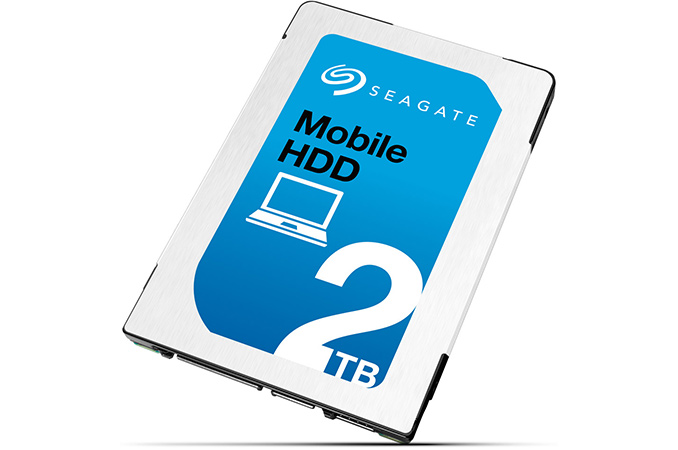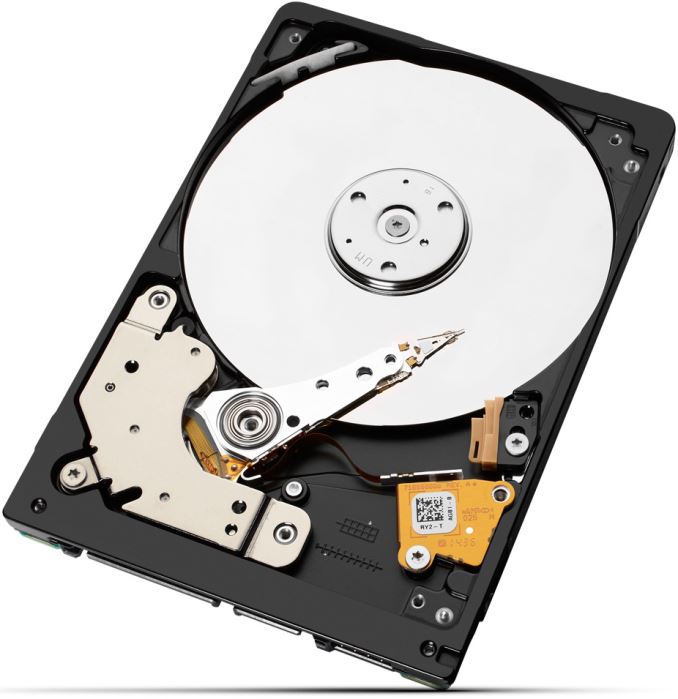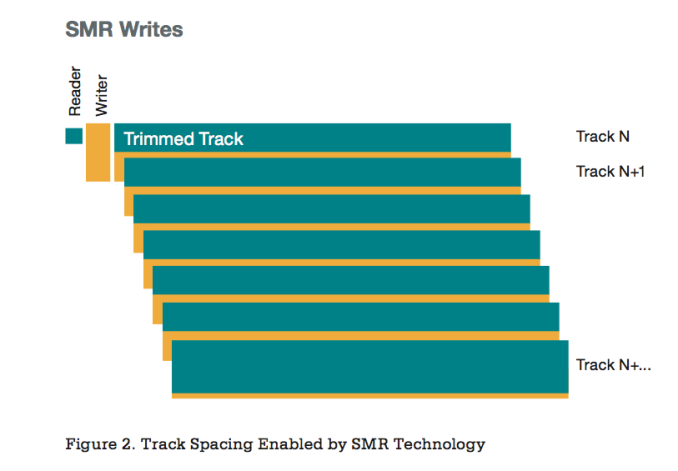Seagate Begins to Ship 2.5-Inch, 7mm Thick 2 TB Mobile Hard Drives with SMR
by Anton Shilov on February 18, 2016 8:00 AM EST- Posted in
- HDDs
- Storage
- Seagate
- SMR
- Mobile HDD
- Cold Storage
- 7mm

Seagate has started to ship its highest-capacity hard drives for notebooks. The new HDDs use shingled magnetic recording (SMR) technology with very high areal density as well as slimmed-down mechanics.
The new Seagate Mobile HDD 2 TB is the first hard drive to market in a 2.5-inch/7 mm form-factor with such extreme capacity. The hard drive is based on two 1 TB SMR platters running at 5400 RPM and features 128 MB of cache as well as SATA interface. The maximum sustainable transfer rate of the HDD is 100 MB/s, which is considerably lower than that of mainstream mobile hard drives (145 – 169 MB/s for Seagate’s own laptop HDDs). Seagate declares 13 ms average seek time for the hard drives. The new HDD weighs 3.17 oz (or 90 grams) and is aimed primarily at mobile computers or bulk cold storage, where you can arguably fit eight drives into a single 5.25-inch bay. Supermicro has an 88-bay 4U rack unit where each drive is hotswappable, though that fits a large PC in the rear; if hot-swappable isn't required, we could be looking at nearly 200+ per storage 4U rack with appropriate backplanes.
Three sets of drives will be offered, in 1TB and 2TB configurations:
| 2TB | 1TB | |
| Base Model | ST2000LM007 | ST1000LM035 |
| Seagate Secure Model (Self Encryption) |
ST2000LM009 | ST1000LM037 |
| Seagate Secure FIPS Model (FIPS 140-2) |
ST2000LM010 | ST1000LM038 |
The SMR technology enables areal densities higher than 1 Tbit per square inch, but at the cost of performance. HDDs featuring shingled recording write new magnetic tracks that overlap part of the previously written tracks, which may slowdown writing since the architecture requires HDDs to rewrite adjacent tracks after any writing operation. In order to “hide” such peculiarities of SMR, Seagate has developed special firmware that ensures optimal writing performance. Part of the reason why Seagate installs a massive 128 MB cache on a 2 TB HDD is because the firmware needs it to store data from tracks that have to be overwritten. Alternatively, it is required to alter operating systems and software, which is not economically feasible.
Usage of SMR technology is justified in environments that are used to archive cold data that is not updated frequently because write performance of such HDDs may be rather slow. Client PCs both read and record data and it remains to be seen whether performance offered by SMR-based client HDDs will be sufficient for the end-user. The Seagate Mobile HDD 2 TB is around 60% slower than the Seagate Laptop HDD 2 TB based on maximum sustainable transfer rate.
Seagate did not disclose whether SMR platters used inside the Mobile HDD 2 TB are made in-house, or by Showa Denko K.K. (SDK), the world’s largest independent producer of hard drive platters. In addition to SMR technology, Seagate used its new mechanics, including new head, preamp, channel and other mechanisms for the Mobile HDD 2 TB HDD. Slimmed down mechanical components allowed Seagate to integrate two platters into a 7 mm hard drive.
Seagate did not reveal any information concerning pricing of its new HDDs. While the product is unique because of its form-factor and capacity, its performance is lower compared to other HDDs. It will be very interesting to see how Seagate prices its new HDD, given its pros and cons.
Related Reading
Seagate to Ship 5TB HDD in 2014 using SMR - Brief SMR Overview
Seagate Mobile HDD Specifications (1TB and 2TB) - Specifications
Source: Seagate












29 Comments
View All Comments
creed3020 - Thursday, February 18, 2016 - link
Thanks for the pipeline post. Most other sites which I read yesterday that talked about this launch missed the fact that this drive is SMR....that is rather critical I would think considering the performance penalty.Now I just wish there were more 2.5" slot based NAS out there!
ZeDestructor - Thursday, February 18, 2016 - link
I have one. It's not very useful now, and won't be anytime soon because of the miserly 1gbit ethernet.About the only reason I can think of for a 2.5" NAS is building a super-fast all-SSD NAS, but you need real network speed for that.
bill.rookard - Thursday, February 18, 2016 - link
Agreed. That would make some of the older HP DL360 servers which utilize the 2.5 hotswaps actually quite usable. You can get them for about $200ish and being able to have 16TB would make them quite practical depending on the cost of the new 2TB drives. That would make a nice lower-power NAS.chekk - Thursday, February 18, 2016 - link
SMR drives, or at least the SMR device managed ones like these, are not good for RAID in a NAS. They are only reasonable for archiving and even the speed there can be painful.I tried out an 8TB 3.5" drive and wrote about 2TB of files sequentially which should have stayed at full speed, but due to how files can get laid down on the disk, it wasn't purely sequential. The speed dropped off quite badly while it moved tracks. This is exactly what Seagate says it will do, which makes it good for only a narrow use case.
monsted - Thursday, February 18, 2016 - link
Done and done. I built a DL380 G5 with six WD Green 2TB 2.5" drives years ago. Still chugging along as a crashplan server for my colleagues. The WD drive is 10mm, but that matches the typical 2.5" SAS drives used in servers.The news here is that 2TB now fits in a laptop, but who would want this slow piece of junk in their laptop?
lmcd - Saturday, February 20, 2016 - link
secondary disk to an SSD in a 15.6in with only one 2.5 in addition to its M2damianrobertjones - Thursday, February 18, 2016 - link
"with such extreme capacity."Will it then be ULTRA extreme when they move to 6mm. What about 5mm? NINJA extreme.
DigitalFreak - Thursday, February 18, 2016 - link
Still waiting on a 7200 RPM 2TB 2.5" drive...fanofanand - Thursday, February 18, 2016 - link
The developers for the game Clash of Kings have already sorted this out. It's "Super Mega Ultra", in that order.statement - Thursday, July 7, 2016 - link
WD2003FZEX